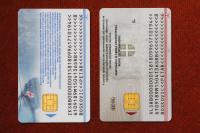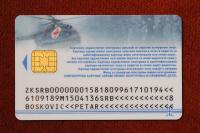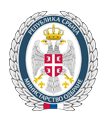- About MoD
Minister and Associates
- Minister
- State Secretary
- Assistant Ministers
- Secretary of the Ministry of Defence
Sectors
- Defence Policy Sector
- Human Resources Sector
- Material Resources Sector
- Budget and Finanance Sector
- Sector for Infrastructure and Hospitality Services
- SAF
- Documents
- Services
- Sport
- Archive
- Contacts
23.04.2010.
Electronic cards in the Ministry of Defence
Since 16 April, the Ministry of Defence of Serbia has started issuing electronic cards for the employees and professional members of the Armed Forces – military identity cards, identification cards, student and cadet IDs, health insurance cards and passes for the visitors.
 According to State Secretary Zoran Vesic, who manages the team for the introduction of electronic ID cards, this would reduce the expenditures of the Ministry of Defence and the Serbian Armed Forces caused by inadequate and uneconomical use of available resources – human, material, financial and information. It would also increase productivity and security of military facilities and security of data in the information systems.
According to State Secretary Zoran Vesic, who manages the team for the introduction of electronic ID cards, this would reduce the expenditures of the Ministry of Defence and the Serbian Armed Forces caused by inadequate and uneconomical use of available resources – human, material, financial and information. It would also increase productivity and security of military facilities and security of data in the information systems. Issuing the multipurpose electronic cards replaces all identification documents and passes which have been in force in the defence system so far, and which have been issued in paper form and had only one purpose.
Military identity card for professional officers, NCOs and soldiers, identification card for civilian personnel, cadets and students, and health card for military health insurance beneficiaries, active military personnel, military pensioners and their families, are the documents to be made and issued in the form of electronic cards until their complete replacement.
The card comes in standard sizes, which is important regarding the use of available commercial electronic card readers. The material from which it is made is the multi-layer polycarbonate characterized by stability and so far it is the best choice for making the electronic identification documents that will be used a lot and for many purposes.
The card contains two chips – the contact and the contactless ones. In the contact chip there is an electronic record of data on the card holder which are located in the visual part. The chip has such characteristics that it can accept all other contents envisaged for the record, with the use of the security systems to protect these contents from the access by unauthorized persons. With regard to the protection, the chip meets the highest prescribed standard.
The contactless chip is primarily intended to enable the user of the electronic card to enter the area with controlled access. Electronically it is not connected to the contact chip so that there is no possibility of remote reading of the contents from the contact chip memory. Cryptographic algorithms are hardware supported.
 Special protection of identification documents has also been achieved, with multiple laser image (MLI), downsized black and white photograph, laminated embossed element, system of thin multicoloured lines, microprint and kinegram specifically designed for members of the Ministry of Defence and the Serbian Armed Forces.
Special protection of identification documents has also been achieved, with multiple laser image (MLI), downsized black and white photograph, laminated embossed element, system of thin multicoloured lines, microprint and kinegram specifically designed for members of the Ministry of Defence and the Serbian Armed Forces. New cards in the initial period will be used for identification, control of access to facilities and rooms, authorization in accessing computers and computer networks, and during their application, other services such as electronic signatures and the like will be developed.
In addition to data printed on the cards – name and surname, identification number, capacity, serial number and date of issue, and blood type and term of validity of the document – the chips contain also information on the service of the person who is issued the electronic card, such as rank, military mail, place of service, name of unit or institution to which he belongs.
Since the electronic cards are programmable processing modules, their use accomplishes a significant characteristic of a reliable protection system – private key of a user is never in the computer memory. Operations to create and check a digital signature can be implemented on the very card. Therefore electronic cards are the most acceptable solution for the need of the realisation of cryptographic hardware module on the side of the user and the secure holder of confidential information.
- About MoD
- Jurisdiction
- Organisation scheme
- Description of duties
- Minister and Associates
- Minister
- State Secretary
- Assistant Ministers
- Secretary of the Ministry of Defence
- Sectors
- Defence Policy Sector
- Human Resources Sector
- Material Resources Sector
- Budget and Finanance Sector
- Sector for Infrastructure and Hospitality Services
- Special Internal Units
- Office of the Minister of Defence
- Secretariat
- Military Attorney's Office
- Administrative Bodies within MoD
- Defence Inspectorate
- Military Intelligence Agency
- Military Security Agency
- Autonomous Departments
- Public Relations Department
- Military Healthcare Department
- Higher Education Institution
- Defence University
- Specific internal units
- Inspector General of the Services
- Internal Audit Section
- SAF
- Documents
- Services
- Sport
- Archive
- Contacts

